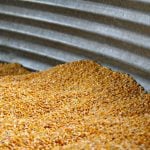This season’s reports about the Brazilian soybean crop have usually talked of good moisture and prospects for a record harvest. They have also said that the world’s voracious demand for vegetable oil and meal demanded that South America have a record crop; otherwise prices would have to rise.
Well, last week Brazil reported that the rain is now a problem, delaying harvest and damaging yield in some key areas. Drought patches elsewhere and Asian rust are also taking a toll.
The problems caused the government to cut its official forecast to 57.66 million tonnes, down a million tonnes from its last forecast and 3.3 million tonnes lower than the last United States Department of Agriculture estimate.
Read Also

Why feds imposed EV tariffs
Moe and Kinew have a fight on their hands when it comes to eliminating the EV tariff. Canada has to worry about pissing off the U.S. and Mexico and hundreds of thousands of auto workers.
A key private Brazilian analyst, Safras, put its crop estimate even lower, at 56.6 million tonnes from its previous estimate of 59.7 million.
All these forecasts still mark a new record for Brazilian production, but the world was counting on a crop of more than 60 million tonnes.
Also, although Argentine estimates have not changed, continuing dryness is thought to be limiting yields there.
As this column was being written Feb. 23, soybean prices hit 151/2 year highs, carrying canola along with them.
Continued high ocean shipping costs are also a factor. The U.S. is closer to China than Brazil and therefore has lower shipping costs, giving an incentive to buy from the U.S. This supports U.S. soybean prices.
Speaking of China, it wound up a wheat mission to the U.S. last week and made commitments to ship 1.7 million tonnes of U.S. wheat from the U.S. Pacific Northwest in 2004.
That shook wheat markets, causing Minneapolis spring wheat futures to soar to 15-month highs Feb. 23.
The cheery news helped offset a sober pool return forecast from the Canadian Wheat Board for the 2004-05 crop year.
The outlook was based on increased production prospects in Europe, the former Soviet Union and India, but it is an early forecast talking about crops that are not yet seeded or out of winter dormancy. A lot can happen before harvest.
Currency markets are also uncertain, but it seems a safe bet that the Canadian dollar will average above what it was during the 2003-04 crop year, and that will lower the pool returns.














